I know that as a proper food blogger I am supposed to record in prose and pictures my kitchen successes , the following piece therefore starts badly.
Last year was the first time I made Membrillo , aka ; Quince Paste or Cheese, Marmalade de Coing , or in Provence ; Cotignac.
All went well last year and I recorded my efforts in my blog on 27th October 2010.
This year I headed out to pick some quinces by the roadside to repeat the experiment. I was determined to get more than the couple of kilos of membrillo I got last year as it is totally delicious with cheese and had proved so popular with customers that I had run out by March.
The best laid schemes however…..
Whether it was the wrong sort of weather at the wrong moment or other actions of the moon the crop of Quinces in Languedoc this year was very poor.
I managed to pick a mere couple of kilos of very worm eaten Quinces and then decided to stretch these out with some grape juice gleaned from the grapes which the harvesting had left on the vines and the juice of some pomegranates which were growing wild at the road side.
The quinces I covered with water, added the juices and boiled until all were soft.
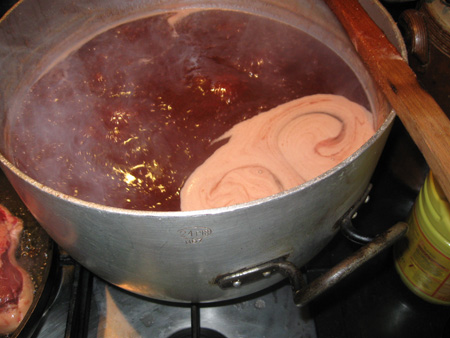
Then I put this through the mouli-legumes to make a puree, added three quarters of their weight in sugar and proceeded to boil until the desired consistency was achieved.
(the text books say you should leave a line in the mixture when you draw your spoon through)
This however did not happen , but , undaunted I decided to pour the long boiled mixture (now a most glorious deep dark crimson) into my prepared tins and see what happened.
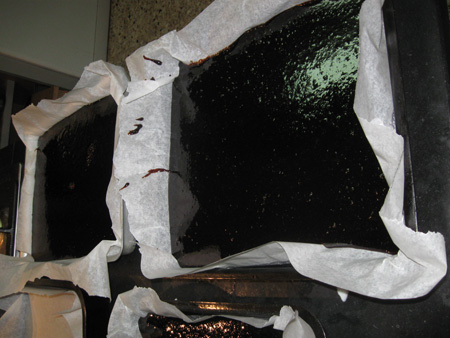
It looked brilliant while it was setting but as it set – and boy did it set- I realised that I had a disaster on my hands.
I have read about a sort of fruit pemmican called fruit leather, well I had achieved it- this stuff could sole shoes.
Despite all attempts to reboil with extra water it remained unusable so I cut some into little pieces to use as a sort of fruit stock cube and binned the rest.
Yesterday being a wet day (an unusual occurance) I decided to put my pride in my pocket and go and purchase Quinces in the supermarket.
I bought 4 Kilos (they are selling at the moment for the not exorbitant price of €1.15 a kilo)
I then bought 5 kilos of caster sugar and headed to the check out.
There (of course ) I had to explain to madame le checkout that , as it was a wet day I intended to settle in the kitchen for the day and make Membrillo. Madame agreed that this was a long arduous travail and when I said that this was the first year I hadn’t been able to get any from the hedgerows I suddenly found myself in the centre of a large discussion. The woman behind me, and the gentleman behind her, all agreed with me and agreed that there was a mysterious dearth of Quinces this year.
This marked the first time I have ever ended up in a conversation around the checkout as the French reserve was melted with their concern at the unfairness of the failure of the quince harvest.
I paid and left the counter accompanied with choruses of “Bon Courage !” from my new friends.
(There is nothing more uniting in France than the subject of food)
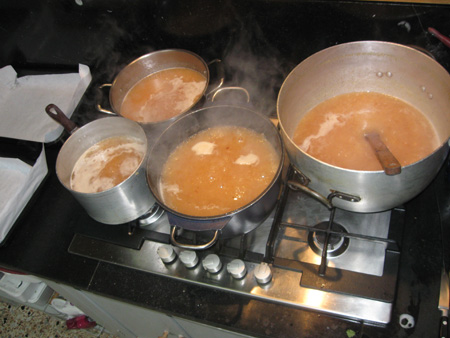
This time I decided to be extremely careful in my manufacture of the Membrillo.
First I cooked my chopped four kilos of Quinces (immaculate beauties from Provence) and boiled them until tender.
Then I put the lot through my muli legoume (a labour of love) measured the end result (it came to eight litres) added three quarters of the weight in caster sugar and brought the whole lot up to the boil in my large ham pot.
Once the sugar had melted and it had achieved a simmer I divided the lot between four of my largest pots to boil down to produce the paste- this to avoid what I reckoned the reason behind my fruit leather fiasco- trying to cook too much at the same time in one large pot.
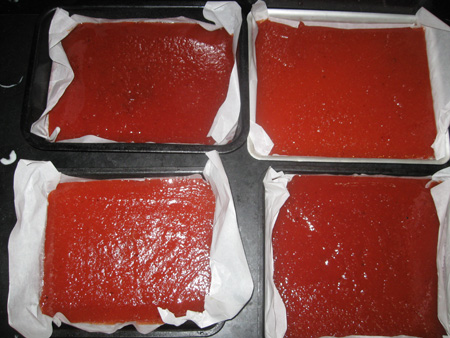
You will I am sure be pleased to know that after about an hour the necessary thickness was achieved and I was able to pour the contents into my trays.
There followed an anxious couple of hours as I waited for them to set.
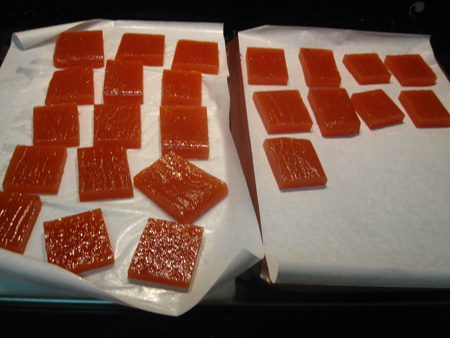
Success !
Perfect Membrillo and over 10 kilos of it.
Enough for the full year I hope and some left over to give as presents.
This was yesterdays work- made so much easier as the election results trickled in from Ireland- I think I will always associate Michael D’s victory with my own victory over the quince.
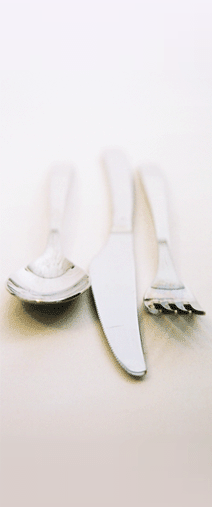
Comments
michael waterfield
on November 8, 2011What bad luck Martin! there is something that goes against the grain for a chef to have to throw a labour of love away.
Interesting that caster sugar works for you. usually granulated is recommended for jams because it produces less scum than caster.
the Pays d’Oc name for quince cheese ‘cotignac’ is very similar to the Italian which is ‘cotignata’.
Finally, Sam Clark of Moro has an interesting recipe for quince aioli. sounds unlikely but it works.
250gs quince paste
1 clove garlic (less than usual)
150mls half olive oil half sunflower oil
lemon juice to taste
salt and pepper
mash the quince with the lemon and add egg yolks, garlic and gradually oil
love to you both michael
The comments are closed.